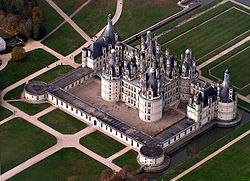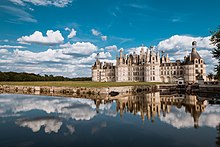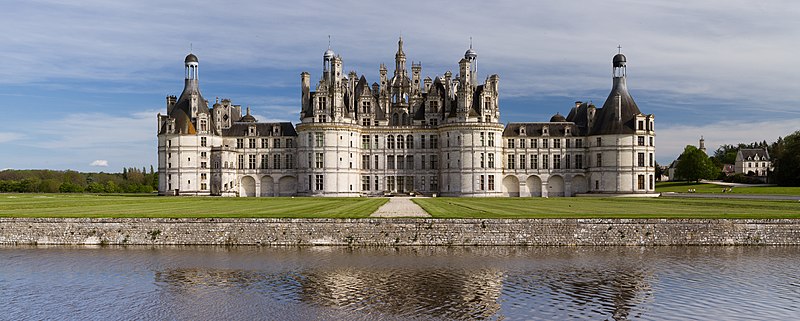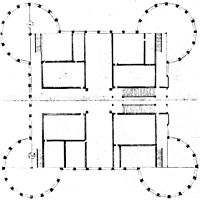Château de Chambord
| Château de Chambord | |
|---|---|
 Aerial view of the Château de Chambord | |
| General information | |
| Status | Extant |
| Architectural style | French Renaissance, Classical Renaissance |
| Location | Chambord, Loir-et-Cher, France |
| Address | Chateau 41250, Chambord, France |
| Coordinates | 47°36′58″N 01°31′02″E / 47.61611°N 1.51722°E |
| Construction started | 1519 |
| Completed | 1547 |
| Height | 56 m (184 ft) |
| Design and construction | |
| Architect(s) | Domenico da Cortona |
| Structural engineer | Pierre Nepveu |
| Website | |
| Official site of the Chateau de Chambord | |
| Official name | The Loire Valley between Sully-sur-Loire and Chalonnes, previously inscribed as Chateau and Estate of Chambord |
| Type | Cultural |
| Criteria | i, ii, vi |
| Designated | 1981 (5th session) |
| Reference no. | 933 |
| Region | Europe |
The Château de Chambord (French pronunciation: [ʃɑto d(ə) ʃɑ̃bɔʁ]) in Chambord, Centre-Val de Loire, France, is one of the most recognisable châteaux in the world because of its very distinctive French Renaissance architecture, which blends traditional French medieval forms with classical Renaissance structures. The building was constructed by the king of France, Francis I.[1]
Chambord is the largest château in the Loire Valley; it was built to serve as a hunting lodge for Francis I, who maintained his royal residences at the Château de Blois and Amboise. The original design of the château is attributed to the Tuscan architect Domenico da Cortona; Leonardo da Vinci may have also influenced the design.[1]
Chambord was altered considerably during the 28 years of its construction (1519–1547), during which it was overseen on-site by Pierre Neveu. With the château nearing completion, Francis showed off his enormous symbol of wealth and power by hosting his old archrival, Charles V, Holy Roman Emperor, at Chambord.
In 1792, in the wake of the French Revolution, some of the furnishings were sold and timber removed. For a time the building was left abandoned, though in the 19th century some attempts were made at restoration. During the Second World War, art works from the collections of the Louvre and the Château de Compiègne were moved to the Château de Chambord. The château is now open to the public, receiving 700,000 visitors in 2007. Flooding in June 2016 damaged the grounds but not the château itself.
Architecture
[edit]

Châteaux in the 16th century departed from castle architecture.[nb 1] Indeed, while they were off-shoots of castles, with features commonly associated with them, they did not have serious defences. Extensive gardens and water features, such as a moat, were common amongst châteaux from this period. Chambord is no exception to this pattern. The layout is reminiscent of a typical castle with a keep, corner towers, and defended by a moat.[4] Built in Renaissance style, the internal layout is an early example of the French and Italian style of grouping rooms into self-contained suites, a departure from the medieval style of corridor rooms.[5][nb 2] The massive château is composed of a central keep with four immense bastion towers at the corners. The keep also forms part of the front wall of a larger compound with two larger towers. Bases for a possible further two towers are found at the rear, but these were never developed, and remain the same height as the wall. The château features 440 rooms, 282 fireplaces, and 84 staircases. Four rectangular vaulted hallways on each floor form a cross-shape.
The castle was never intended to provide any form of defence from enemies; consequently the walls, towers and partial moat are decorative, and even at the time were an anachronism. Some elements of architecture—open windows, loggias, and a vast outdoor area at the top—borrowed from the Italian Renaissance architecture—are less practical in cold and damp northern France.

The roofscape of Chambord contrasts with the masses of its masonry and has often been compared with the skyline of a town:[7] it shows 11 kinds of towers and three types of chimneys, without symmetry, framed at the corners by the massive towers. The design parallels are north Italian and Leonardesque. Writer Henry James remarked, "the towers, cupolas, the gables, the lanterns, the chimneys, look more like the spires of a city than the salient points of a single building."[8][9]

One of the architectural highlights is the spectacular open double-spiral staircase that is the centrepiece of the château.[1] The two spirals ascend the three floors without ever meeting, illuminated from above by a sort of light house at the highest point of the château. There are suggestions that Leonardo da Vinci may have designed the staircase, but this has not been confirmed.[1] Writer John Evelyn said of the staircase, "it is devised with four [sic] entries or ascents, which cross one another, so that though four persons meet, they never come in sight, but by small loopholes, till they land. It consists of 274 steps (as I remember), and is an extraordinary work, but of far greater expense than use or beauty."[9]
The château also features 128 metres (420 ft) of façade, more than 800 sculpted columns and an elaborately decorated roof. When Francis I commissioned the construction of Chambord, he wanted it to look like the skyline of Constantinople.
The château is surrounded by a 52.5-square-kilometre (13,000-acre) wooded park and game reserve maintained with red deer, enclosed by a 31-kilometre (19-mile) wall. The king's plan to divert the Loire to surround the château came about only in a novel; Amadís de Gaula, which Francis had translated. In the novel the château is referred to as the Palace of Firm Isle.
Chambord's towers are atypical of French contemporary design in that they lack turrets and spires. In the opinion of author Tanaka Hidemichi, who suggests Leonardo da Vinci influenced the château's design, they are closer in design to minarets of 15th-century Milan.[7]
History
[edit]Royal ownership
[edit]Who designed the Château de Chambord is a matter of controversy.[10] The original design is attributed, though with several doubts, to Domenico da Cortona, whose wooden model for the design survived long enough to be drawn by André Félibien in the 17th century.[11] In the drawings of the model, the main staircase of the keep is shown with two straight, parallel flights of steps separated by a passage and is located in one of the arms of the cross. According to Jean-Guillaume, this Italian design was later replaced with the centrally located spiral staircase, which is similar to that at Blois, and a design more compatible with the French preference for spectacular grand staircases. However, "at the same time the result was also a triumph of the centralised layout—itself a wholly Italian element."[12] In 1913 Marcel Reymond suggested[13] that Leonardo da Vinci, a guest of Francis at Clos Lucé near Amboise, was responsible for the original design, which reflects Leonardo's plans for a château at Romorantin for the King's mother, and his interests in central planning and double-spiral staircases; the discussion has not yet concluded,[14] although many scholars now agree that Leonardo was at least responsible for the design of the central staircase.[15][1]
Archaeological findings by Jean-Sylvain Caillou & Dominic Hofbauer have established that the lack of symmetry of some façades derives from an original design, abandoned shortly after the construction began, and which ground plan was organised around the central staircase following a central gyratory symmetry.[16] Such a rotative design has no equivalent in architecture at this period of history, and appears reminiscent of Leonardo da Vinci's works on hydraulic turbines or the helicopter. Had it been respected, it is believed that this unique building could have featured the quadruple-spiral open staircase, strangely described by John Evelyn and Andrea Palladio, although it was never built.
Regardless of who designed the château, on 6 September 1519 Francis de Pontbriand was ordered to begin construction of the Château de Chambord.[17] The work was interrupted by the Italian War of 1521–1526, and work was slowed by dwindling royal funds[18] and difficulties in laying the structure's foundations. By 1524, the walls were barely above ground level.[17] Building resumed in September 1526, at which point 1,800 workers were employed in building the château. At the time of the death of King Francis I in 1547, the work had cost 444,070 livres.[18]

The château was built to act as a hunting lodge for King Francis I;[5] however, the King spent barely seven weeks there in total, that time consisting of short hunting visits. As the château had been constructed with the purpose of short stays, it was not practical to live in on a longer-term basis. The massive rooms, open windows and high ceilings meant heating was impractical. Similarly, as the château was not surrounded by a village or estate, there was no immediate source of food other than game. This meant that all food had to be brought with the group, typically numbering up to 2,000 people at a time.
As a result of all the above, the château was completely unfurnished during this period. All furniture, wall coverings, eating implements and so forth were brought specifically for each hunting trip, a major logistical exercise. It is for this reason that much furniture from the era was built to be disassembled to facilitate transportation. After Francis died of a heart attack in 1547, the château was not used for almost a century.
For more than 80 years after the death of King Francis I, French kings abandoned the château, allowing it to fall into decay. Finally, in 1639 King Louis XIII gave it to his brother, Gaston, Duke of Orléans, who saved the château from ruin by carrying out much restoration work.

King Louis XIV had the great keep restored and furnished the royal apartments. The king then added a 1,200-horse stable, enabling him to use the château as a hunting lodge and a place to entertain for a few weeks each year, for example Molière presented the premiere of his celebrated comedy, Le Bourgeois Gentilhomme[19] here. Nonetheless, Louis XIV abandoned the château in 1685.[20]
From 1725 to 1733, Stanisław Leszczyński (Stanislas I), the deposed King of Poland and the father-in-law of King Louis XV, lived at Chambord. In 1745, as a reward for valour, the king gave the château to Maurice de Saxe, Marshal of France, who installed his military regiment there.[21] Maurice de Saxe died in 1750, and once again the colossal château sat empty for many years.
French Revolution and modern history
[edit]
In 1792, the Revolutionary government ordered the sale of the furnishings; the wall panellings were removed and even floors were taken up and sold for the value of their timber, and, according to M de la Saussaye,[22] the panelled doors were burned to keep the rooms warm during the sales; the empty château was left abandoned until Napoleon Bonaparte gave it to his subordinate, Louis Alexandre Berthier. The château was subsequently purchased from his widow for the infant Duke of Bordeaux, Henry Charles (1820–1883) who took the title Count of Chambord. A brief attempt at restoration and occupation was made by his grandfather King Charles X (1824–1830) but in 1830 both were exiled. In Outre-Mer: A Pilgrimage Beyond the Sea, published in the 1830s, Henry Wadsworth Longfellow remarked on the dilapidation that had set in: "all is mournful and deserted. The grass has overgrown the pavement of the courtyard, and the rude sculpture upon the walls is broken and defaced".[23] During the Franco-Prussian War (1870–1871) the château was used as a field hospital.
The final attempt to make use of the colossus came from the Count of Chambord, but after the Count died in 1883, the château was left to his sister's heirs, the titular Dukes of Parma, then resident in Austria-Hungary; firstly Robert, Duke of Parma, who died in 1907 and after him, Elias, Prince of Parma. Any attempts at restoration ended with the onset of World War I in 1914. The Château de Chambord was confiscated as enemy property in 1915, but the family of the duke of Parma sued to recover it, and that suit was not settled until 1932; restoration work was not begun until a few years after World War II ended in 1945.[24] The Château and surrounding areas, some 5,440 hectares (13,400 acres; 21.0 sq mi), have belonged to the French state since 1930.[25]

In 1939, shortly before the outbreak of World War II, the art collections of the Louvre and Compiègne museums (including the Mona Lisa)[citation needed] were stored at the Château de Chambord. An American B-24 Liberator bomber crashed onto the château lawn on 22 June 1944.[26] The image of the château has been widely used to sell commodities from chocolate to alcohol and from porcelain to alarm clocks; combined with the various written accounts of visitors, this made Chambord one of the best known examples of France's architectural history.[27] Today, Chambord is a major tourist attraction, and in 2007 around 700,000 people visited the château.[23]
After unusually heavy rainfall, Chambord was closed to the public from 1 to 6 June 2016. The River Cosson, a tributary of the Loire, flooded its banks and the château's moat. Drone photography documented some of the peak flooding.[28] The French Patrimony Foundation described effects of the flooding on Chambord's 13,000-acre (5,300 ha) property. The 20-mile (32 km) wall around the château was breached at several points, metal gates were torn from their framing, and roads were damaged. Trees were also uprooted and certain electrical and fire protection systems were put out of order. However, the château itself and its collections reportedly were undamaged. The foundation observed that paradoxically the natural disaster effected Francis I's vision that Chambord appears to rise from the waters as if it were diverting the Loire.[29] Repairs are expected to cost upwards of a quarter-million dollars.[30]

Influence
[edit]
The Château de Chambord has further influenced a number of architectural and decorative elements across Europe. Château de Chambord was the model for the reconstruction and new construction of the original Schwerin Palace between 1845 and 1857.[31][32]
Yet in the later half of the 19th century, the château's style proliferated across the United Kingdom, influencing the Founder's Building at Royal Holloway, University of London, designed by William Henry Crossland[33] and the main building of Fettes College in Edinburgh, designed by David Bryce in 1870.[34][35] Between 1874 and 1889, the country house in Buckinghamshire, Waddesdon Manor, was built with similar architectural frameworks as the Château de Chambord, disseminated via the architect Gabriel-Hippolyte Destailleur. For instance, the twin staircase towers, on the north façade, were inspired by the staircase tower at the château.[36] However, following the theme of unparalleled luxury at Waddesdon, the windows of the towers at Waddesdon were glazed, unlike those of the staircase at Chambord, and were far more ornate.
In popular culture
[edit]- Cordel Encantado (2011) – in 2011, Château de Chambord served as the setting to represent the fictional kingdom of Serafia do Norte in the Brazilian telenovela.[37]
- Valiant Hearts (2021) – during World War II, six Jewish children are hidden by the French Resistance in the Château de Chambord to escape the Holocaust.[38]
- Like a Prince (2023) – the main character portrayed by Ahmed Sylla is sentenced to community service at the Château de Chambord.[39][40]
Gallery
[edit]References
[edit]Notes
- ^ Although château and castle derive from the Latin castellum,[2] their meaning is different. In French, château-fort refers to a castle, while château more properly describes a country house.[3]
- ^ Viollet-le-Duc, however, in his Dictionnaire raisonné de l'architecture française (1885) found that there was "nothing Italianate [about Chambord] ..., in thought or in form".[6]
Footnotes
- ^ a b c d e Bernhard, Adrienne (17 March 2020). "The unsolved mystery of France's iconic Loire Valley". BBC. Retrieved 18 March 2020.
- ^ Creighton & Higham 2003, p. 6
- ^ Thompson 1994, p. 1
- ^ Thompson 1994, pp. 117–120
- ^ a b Yarwood 1974, p. 323
- ^ Viollet-le-Duc 1875, p. 189, quoted in Tanaka 1992, p. 85
- ^ a b Tanaka 1992, p. 96
- ^ James, Henry (1907) [1900]. A Little Tour in France (2nd ed.). London: William Heinemann. p. 40.
- ^ a b Quoted in Garrett 2010, p. 78
- ^ Tanaka 1992, p. 85
- ^ Félibien 1681, pp. 28–29 (Félibien's description of the model).
- ^ Guillaume 1996, p. 416.
- ^ Reymond 1913
- ^ Heydenreich 1952; Tanaka 1992
- ^ Hanser 2006, p. 47.
- ^ Château de Chambord programme archéologique chambord-archeo.com, accessed 18 February 2019
- ^ a b Heydenreich 1952, p. 282
- ^ a b Tanaka 1992, pp. 92–93
- ^ HISTORY UNFOLDS
- ^ Chirol & Seydoux 1992, p. 53
- ^ Boucher 1980, p. 34
- ^ Saussaye, Le Château de Chambord (Blois) 1865 etc.
- ^ a b Quoted in Garrett 2010, p. xxii
- ^ Château de Chambord: Well Preserved Renaissance Château in France castlesandmanorhouses.com, accessed 18 February 2019
- ^ "Presentation". Chambord.org. Archived from the original on 7 November 2013. Retrieved 15 June 2013.
- ^ "Liberator 22 juin 1944 – Chambord – Aérostèles". Aerosteles.hydroretro.net. 31 May 2008. Archived from the original on 21 August 2009. Retrieved 27 March 2011.
- ^ Garrett 2010, pp. 78–79
- ^ Atherton, Kelsey D. (3 June 2016). "Drone Films Flooded French Castle". Popular Science. Archived from the original on 19 June 2016. Retrieved 18 June 2016.
- ^ "Sauvegarde Du Domaine De Chambord Après Inondations". Fondation du Patrimoine (in French). Archived from the original on 13 October 2016. Retrieved 18 June 2016.
- ^ "Video: France’s famed Chambord castle left heavily damaged after floods". France 24. 6 August 2016. Accessed 24 December 2022.
- ^ "Schweriner Schloss". schwerin.m-vp.de, accessed 18 February 2019
- ^ Schöner als das Vorbild svz.de, accessed 18 February 2019.
- ^ "Original features". Times Higher Education. 5 February 2009
- ^ "Fettes College: The Building". Archived 6 January 2019 at the Wayback Machine. Retrieved 21 March 2009
- ^ Gillian Tait (2016). "Fettes College" in 111 Places in Edinburgh That You Shouldn't Miss. Emons Verlag GmbH. Retrieved 19 February 2019.
- ^ Girouard, Mark A Hundred Years at Waddesdon, published by Rothschild Waddesdon, 1998: 24
- ^ "BASTIDORES". memoriaglobo (in Brazilian Portuguese). 29 October 2021. Retrieved 22 February 2024.
- ^ "Valiant Hearts de Mona Achache (2021)". Unifrance. Archived from the original on 7 October 2022. Retrieved 4 December 2023.
- ^ "Like a Prince (2023)". Unifrance. Retrieved 11 January 2024.
- ^ "Loir-et-Cher : le château de Chambord, décor naturel de "Comme un prince" avec Ahmed Sylla". La Nouvelle République du Centre-Ouest (in French). 14 December 2023.
Bibliography
- Boucher, J.J. (1980), Chambord (in French), Fernand Lanore
- Chirol, Serge; Seydoux, Philippe (1992), Chateaux of the Val de Loire, Vendôme Press, ISBN 978-0-8656-5134-0
- Creighton, Oliver; Higham, Robert (2003), Medieval Castles, Shire Archaeology, ISBN 978-0-7478-0546-5
- Félibien, André (1681). Mémoires pour servir à l'histoire des maisons royales, published for the first time from the manuscript in the Bibliothèque nationale in 1874. Paris: J. Baur. Copy at Google Books.
- Garrett, Martin (2010), The Loire: a Cultural History, Oxford University Press, ISBN 978-0-19-976839-4
- Guillaume, Jean (1996). "Chambord, château of", vol. 6, pp. 415–417, in The Dictionary of Art, edited by Jane Turner, reprinted with minor corrections in 1998. New York: Grove. ISBN 978-1-8844-4600-9.
- Caillou, Jean-Sylvain; Hofbauer, Dominic (2016). Chambord, le projet perdu de 1519. Faton. p. 64. ISBN 978-2-8784-4228-1.
- Hanser, David A. (2006). Architecture of France. Westport, Connecticut: Greenwood Press. ISBN 978-0-313-31902-0.
- Heydenreich, Ludwig H. (October 1952), "Leonardo da Vinci, Architect of Francis I", The Burlington Magazine, 94 (595): 277–285, JSTOR 870959
- Reymond, Marcel (June 1913), "Leonardo da Vinci, architect de Chambord", Gazette des Beaux-Arts: 413–460
- Tanaka, Hidemichi (1992), "Leonardo da Vinci, Architect of Chambord?", Artibus et Historiae, 13 (25): 85–102, doi:10.2307/1483458, JSTOR 1483458
- Thompson, M. W. (1994) [1987], The Decline of the Castle, Magna Books, ISBN 978-1-8542-2608-2
- Viollet-le-Duc, Eugene (1875), Dictionnaire raisonné de l'architecture française du XIe au XVIe siècle, vol. 3
- Yarwood, Doreen (1974), The Architecture of Europe, London: B. T. Batsford
Further reading
[edit]- Gebbelin, François (1927), Les Châteaux de la Renaissance
External links
[edit]- World History Encyclopedia - Chateau de Chambord
- Château de Chambord
- Programme archéologique de Chambord
- Rendez-vous at the National Domain of Chambord Archived 6 June 2016 at the Wayback Machine – Official website for tourism in France (in English)
- 360° Panoramas of Le Château de Chambord' Archived 20 December 2012 at the Wayback Machine by the Media Center for Art History, Columbia University
- Châteaux in Loir-et-Cher
- Châteaux of the Loire Valley
- Museums in Loir-et-Cher
- National museums of France
- Historic house museums in Centre-Val de Loire
- Houses completed in 1547
- Hunting museums
- Hunting lodges in France
- Palaces in France
- Royal residences in France
- Double spiral staircases
- Stairways
- Monuments historiques of Loir-et-Cher
- Ancien Régime French architecture
- French Renaissance architecture
- Renaissance architecture in France
- 1547 establishments in France
- Castles in France
- Henri, Count of Chambord









